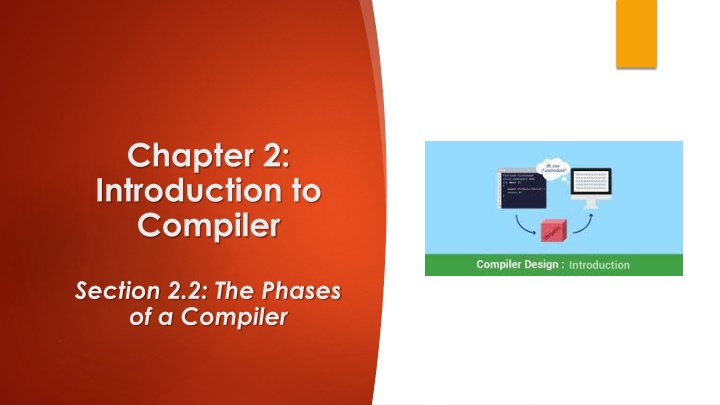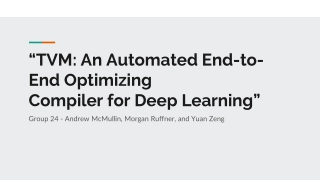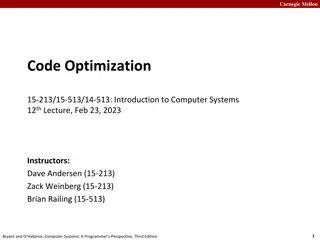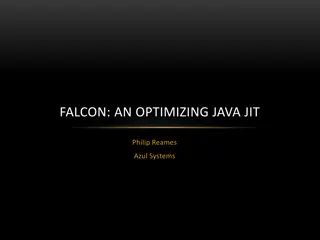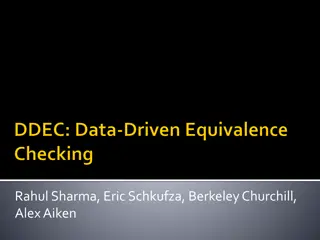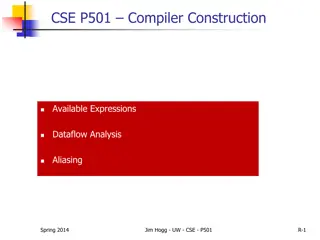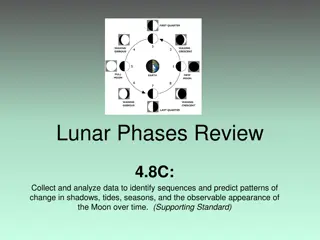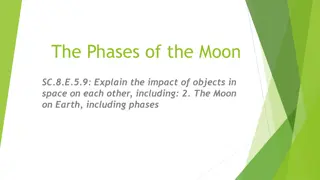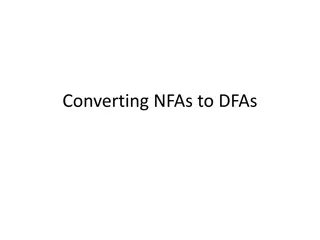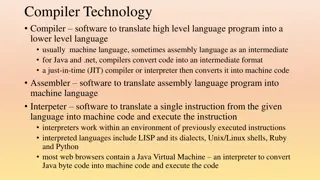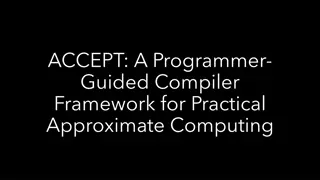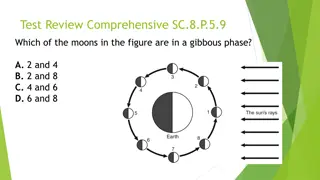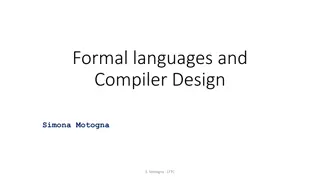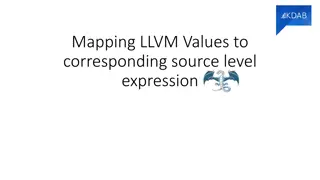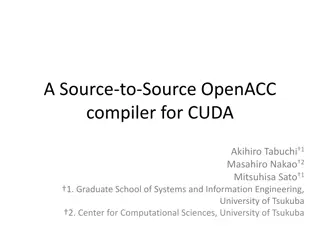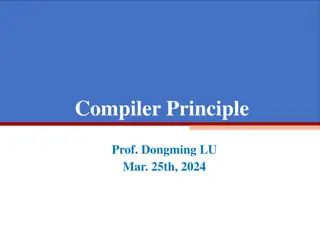Compiler Phases Overview
This content provides a detailed exploration of the phases of a compiler, including lexical analysis, syntax analysis, and code generation. It explains the purpose and process of each phase, with examples and illustrations to aid in understanding.
Download Presentation

Please find below an Image/Link to download the presentation.
The content on the website is provided AS IS for your information and personal use only. It may not be sold, licensed, or shared on other websites without obtaining consent from the author.If you encounter any issues during the download, it is possible that the publisher has removed the file from their server.
You are allowed to download the files provided on this website for personal or commercial use, subject to the condition that they are used lawfully. All files are the property of their respective owners.
The content on the website is provided AS IS for your information and personal use only. It may not be sold, licensed, or shared on other websites without obtaining consent from the author.
E N D
Presentation Transcript
Chapter 2: Introduction to Compiler Section 2.2: The Phases of a Compiler
Learning Outcome(s) By the end of the lesson, students should be able to: Define, explain and differentiate compiler and interpreter Able to use big C notation for compiler Illustrate the phases of a compiler
The Phases of a Compiler Compiler consists of three phases Lexical analysis (scanner) Syntax analysis Code generation To simplify compiler design and construction process
Lexical Analysis Also known as lexical scanner. Isolate the words in an input string. A word is also known as lexeme (a lexical item/token) word a string of input characters, taken as a unit and passed to the next phase of compilation. Examples: Key words: while, void, if, for, . Identifiers: declared by the programmer Operators: +,-,*,/,=,==, .. Numeric constants: 123, 0.123E, 12.34, etc. Character constants: character(s) enclosed in quotes Special characters: used as delimiters ( ) , ; : Comments: identified by scanner, ignored by output
Lexical Analysis The output of the lexical phase is stream of tokens corresponding to the words described previously. This phase builds table(s) (called symbol table), store all identifiers used in the source program. Sample Problem: Show the token classes, or words , put out by the lexical analysis phase corresponding to this Java source input: sum = sum + unit / accumulate sum / 1.2e-12 ; Solution: identifier (sum) assignment (=) identifier (sum) operator (+) identifier (unit) operator ( ) numeric constant (1.2e-12)
Syntax Analysis Checks for syntax errors in the source program, using, as input, tokens put out by the lexical phase and producing, as output, a stream of atoms or syntax trees. Atom A record put out by the syntax analysis phase of a compiler which specifies a primitive operation and operands. Example: MULT, ADD, and MOVE could represent atomic operations for multiplication, addition, and moving data in memory. Each operation could have 0 or more operands also listed in the atom: (operation, operand1, operand2, operand3). The meaning of the following atom would be to add A and B, and store the result into C: (ADD, A, B, C)
Sample Problem 1.2 (b) Show atoms corresponding to the following Java statement: A = B + C D ; Solution: (MULT,C,D,TEMP1) (ADD,B,TEMP1,TEMP2) (MOVE,TEMP2,A) Sample Problem 1.2 (c) Show atoms corresponding to the Java statement: while (A<=B) A = A + 1; Solution: (LBL, L1) (TEST, A, <=, B, L2) (JMP, L3) (LBL, L2) (ADD, A, 1, A) (JMP, L1) (LBL, L3)
Syntax tree A tree data structure showing the structure of a source program or statement, in which the leaves represent operands, and the internal nodes represent operations or control structures. Example A Syntax Tree for A = B + C D = A + B * C D
Sample Problem Syntax tree Show a syntax tree for the Java statement if (A+3<400) A = 0; else B = A A; Assume that an if statement consists of three subtrees, one for the condition, one for the consequent statement, and one for the else statement, if necessary. Solution if < = = + 400 A 0 B * A 3 A A
The Phases of a Compiler Source Program Lexical Analysis Tokens Syntax Analysis Atom Global Optimization Atom Code Generator Instructions Local Optimization Instructions
Code Generation : Produces machine language object code from syntax trees or atoms. Example: An ADD atom might be translated to three machine language instructions: (1)load the first operand into a register, (2) add the second operand to that register, and (3) store the result, as shown for the atom (ADD, A, B, Temp): LOD R1,A // Load A into reg. 1 ADD R1,B // Add B to reg. 1 STO R1,Temp // Store reg. 1 in Temp
Sample Problem 1.2 (e) Show assembly language instructions corresponding to the following atom string: (ADD, A, B, Temp1) (TEST, A, ==, B, L1) (MOVE, Temp1, A) (LBL, L1) (MOVE, Temp1, B) Solution: LOD R1,A ADD R1,B STO R1,Temp1 // ADD, A, B, Temp1 CMP A,B BE L1 // TEST, A, ==, B, L1 MOV A,Temp1 // MOVE, Temp1, A L1: MOV B,Temp1 // MOVE, Temp1, B
Implementation Techniques Computer Name Program loaded in computer s RAM input output Notation for a Program Running on a Computer 1. The program loaded into the computer s memory will be a compiler. 2. A computer is capable of running only programs written in the machine language of that computer.
M Notation for a compiler being translated to a different language 3. The subscript language (the language in which it exists) of the executing compiler (the one inside the computer), M, must be the machine language of the computer on which it is running. 4. The subscript language of the input, S, must be the same as the source language of the executing compiler. 5. The subscript language of the output, O, must be the same as the object language of the executing compiler.
Sample Problem Show the output of the following compilation using the big C notation. Sun ? Solution Sun
Bootstrapping The process of using a program as input to itself as in compiler development through a series of increasingly larger subsets of the source language. Bootstrapping a compiler We want this compiler We write these two small compilers Sun Bootstrapping Java onto a Sun Computer
Cross compiling The process of generating a compiler for a new computer architecture, automatically. We want this compiler We write this compiler We already have this compiler Sun Sun
Compiling To Intermediate Form It is possible to compile to an intermediate form, which is a language somewhere between the source high-level language and machine language. The stream of atoms put out by the parser is a possible example of an intermediate form. The primary advantage of this method is that one needs only one translator for each high-level language to the intermediate form (each of these is called a front end) and only one translator (or interpreter) for the intermediate form on each computer (each of these is called a back end)
Decaf class Cosine { { float cos, x, n, term, eps, alt; /* compute the cosine of x to within tolerance eps */ /* use an alternating series */ x = 3.14159; eps = 0.0001; n = 1; cos = 1; term = 1; alt = -1; while (term>eps) { term = term x x / n / (n+1); cos = cos + alt term; alt = -alt; n = n + 2; } } public static void main (String [] args) } /*cos(x) = 1 - x2/2 + x4/24 - x6/720 + ...*/
Program class identifier { public static void main (String[] identifier) CompoundStmt } Declaration Type IdentList ; Type int | float IdentList identifier , IdentList | identifier Stmt AssignStmt | ForStmt | WhileStmt | IfStmt | CompoundStmt | Declaration | NullStmt A ssignStmt AssignExpr ; ForStmt for ( OptAssignExpr; OptBoolExpr ; OptAssignExpr ) Stmt OptAssignExpr AssignExpr | OptBoolExpr BoolExpr | WhileStmt while ( BoolExpr ) Stmt IfStmt if ( BoolExpr ) Stmt ElsePart ElsePart else Stmt | CompoundStmt { StmtList } StmtList StmtList Stmt | NullStmt ; BoolExpr Expr Compare Expr Compare == | < | > | <= | >= | != Expr AssignExpr | Rvalue AssignExpr identifier = Expr Rvalue Rvalue + Term | Rvalue - Term | Term Term Term * Factor | Term / Factor | Factor Factor ( Expr ) | - Factor | + Factor | identifier | number
